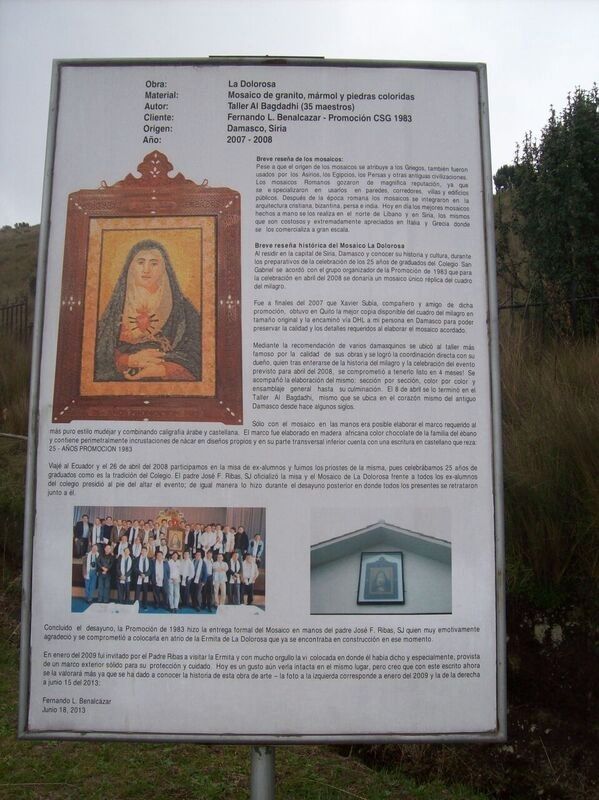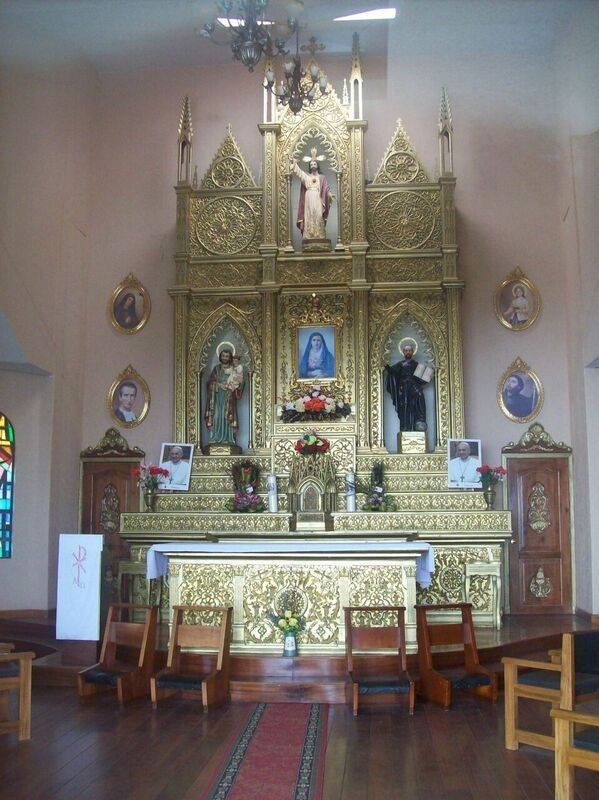Quito, Pichincha, Ecuador — Northwestern South America
La Dolorosa Mosaic
El Mosaico de La Dolorosa
Inscription.
Obra: La Dolorosa
Material: Mosaico de granito, mármol y piedras coloridas
Autor: Taller Al Bagdadhi (35 maestros)
Cliente: Fernando L. Benalcázar – Promoción CSG 1983
Origen: Damasco, Siria
Ano: 2007 – 2008
Breve reseña de los mosaicos:
Pese a que el origen de los mosaicos se atribuya a los Griegos, también fueron usados por los Asirios, los Egipcios, los Persas y otros antiguas civilizaciones. Los mosaicos Romanos gozaron de magnífica reputación, ya que se especializaron en usarlos en paredes, corredores, villas y edificios públicos. Después de la época romana los mosaicos se integraron en la arquitectura cristiana bizantina, persa e india. Hoy en día, los mejores mosaicos hechos a mano se los realiza en el norte de Líbano y en Siria, los mismos que son costosos y extremadamente apreciados en Italia y Grecia donde se los comercializa a gran escala.
Breve reseña histórica del Mosaico La Dolorosa:
Al residir en la capital de Siria, Damasco y conocer su historia y cultura, durante los preparativos de la celebración de los 25 años de graduados del Colegio San Gabriel se acordó con el grupo organizador de la Promoción de 1983 que para la celebración en abril del 2008 se donaría un mosaico único réplica del cuadro del milagro.
Fue a finales del 2007 que Xavier Subia, compañero y amigo de dicha promoción obtuvo en Quito la mejor copia disponible del cuadro del milagro en tamaño original y la encaminó vía DHL a mi persona en Damasco para poder preservar la calidad y los detalles requeridos al elaborar el mosaico acordado.
Mediante la recomendación de varios damasquinos, se ubicó al taller más famoso por la calidad de sus obras y se logró la coordinación directa con su dueño, quien tras enterarse de la historia del milagro y la celebración del evento previsto para abril del 2008, se comprometió a tenerlo listo en 4 meses! Se acompañó la elaboración del mismo, sección por sección, color por color y ensamblaje general hasta su culminación. El 8 de abril se lo terminó en el Taller Al Bagdadhi, mismo que se ubica en el corazón mismo del antiguo Damasco desde hace algunos siglos.
Solo con el mosaico en las manos era posible el marco requerida al más puro estilo mudéjar y combinando caligrafía árabe y castellana. El marco fue elaborado en madera africana color chocolate de la familia del ébano y contiene perimetralmente incrustaciones de nácar en diseños propios y en su parte transversal interior cuenta con una escritura en castellano que reza: 25 – Años Promoción 1983
Viajé al Ecuador y el 26 de abril del 2008 participamos en la misa de ex-alumnos y fuimos los priostes de la misma, pues celebrábamos 25 años de graduados como es la tradición del Colegio. El padre José F. Ribas, SJ oficializó la misa y el Mosaico de La Dolorosa frente a todos los ex-alumnos del colegio presidió al pie del altar al evento; de igual manera lo hizo durante el desayuno posterior en donde todos los presentes se retrataron junto a él.
Concluido el desayuno, la Promoción de 1983 hizo la entrega formal del Mosaico en manos del padre José F. Ribas, SJ quien muy emotivamente agradeció y se comprometió a colocarla en atrio de la Ermita de La Dolorosa que ya se encontraba en construcción en ese momento.
En enero del 2009 fui invitado por el Padre Ribas a visitar la Ermita y con mucho orgullo la vi colocada en donde el había dicho y especialmente, provista de un marco exterior sólido para su protección y cuidado. Hoy es un gusto aún verla intacta en el mismo lugar, pero creo que con este escrito ahora se la valorará más ya que se ha dado a conocer la historia de esta obra de arte – la foto a la izquierda corresponde a enero del 2009 y la de la derecho a junio 15 del 2013.
Fernando L. Benalcázar
Junio 18, 2013
English translation:
Name of the Artwork: La Dolorosa
Material: Mosaic made of granite, marble and colorful stones
Author: Al Bagdadhi Workshop (with 35 master mosaic artists)
Client: Fernando L. Benalcázar – Colegio San Gabriel (CSG) Class of 1983
Origin: Damascus, Syria
Year: 2007 - 2008
A short history of mosaics:
Although the origin of mosaics is usually attributed to the Greeks, they were also used by the Assyrians, Egyptians, Persians and other ancient civilizations. Roman mosaics enjoyed great reputation because they specialized in their use on walls, corridors, villas and public buildings. After the Roman era mosaics were integrated into the Byzantine, Persian and Indian Christian architecture. Today, the best handmade mosaics come from northern Lebanon and Syria, were they are costly and extremely appreciated in Italy and Greece where they are marketed on a large scale.
A Brief History of the La Dolorosa Mosaic:
Residing in the Syrian capital, Damascus, and knowing its history and culture, and during the preparations for the celebration of the 25th Anniversary of the Class of 1983 of Colegio San Gabriel, it was agreed, together with the Class of 1983 that for the celebration in April 2008 a replica mosaic would be donated.
In late 2007 Xavier Subia, a friend of the Class of '83, obtained the best available version of La Dolorosa in Quito and sent it to me via DHL to Damascus in order to preserve the quality and details required to develop the mosaic.
Several residents of Damascus recommended the most famous workshop there to do the work, because of the quality of their work. The manager of the workshop, after hearing the story of La Dolorosa and the celebration of the event scheduled for April 2008, promised to have it ready in 4 months! The preparation, section by section, color by color, and general assembly was completed on time. On 8 April the Bagdadhi workshop finished the project. This is the same workshop that has been located in the heart of Old Damascus for several centuries.
The hand-made mosaic was made possible using the Moorish style and combining Spanish and Arabic calligraphy. The framework was developed in African woods, mostly a chocolate-colored ebony with mother of pearl inlays. Around the edge of the mosaic is writing in Spanish that reads: Class of 1983, 25th Anniversary
I traveled to Ecuador and on April 26, 2008 participated in the Mass, with the alumni serving as the hosts, were we celebrated 25 years since our graduation, as is the tradition of the school. Father Joseph F. Ribas, SJ officially said Mass and La Dolorosa mosaic was presented by the alumni to the college.
The Class of 1983 made the formal presentation of the mosaic to Father Joseph F. Ribas, SJ who very movingly thanked all involved and promised to put it in the Chapel of La Dolorosa, which was already under construction at the time.
In January 2009 I was invited by Father Ribas to visit the chapel and saw the mosaic placed there and also provided with a solid outer frame for protection and care. It gives me pleasure to see the mosaic intact in the same place. I hope that this short history will allow others to value it even more. The photo on the left corresponds to January, 2009 and the right to June 15, 2013.
Fernando L. Benalcázar
June 18, 2013
Topics. This historical marker is listed in this topic list: Arts, Letters, Music. A significant historical year for this entry is 1983.
Location. 0° 11.158′ S, 78° 32.288′ W. Marker is in Quito, Pichincha. Marker can be reached from Topatauchi north of Avenida de los Liertadores. Marker is by the entrance walkway to the Ermita de la Dolorosa. From the end of Topatauchi and Avenida de los Liertadores, unnamed roads, and then paths, must be taken to reach the marker which is high on a side of Mount Pichincha. Touch for map. Touch for directions.
Other nearby markers. At least 2 other markers are within 5 kilometers of this marker, measured as the crow flies. Saluda a La Basilica (approx. 4.7 kilometers away); Act of the First Revolutionary Government of Quito (approx. 4.8 kilometers away).
Credits. This page was last revised on September 12, 2016. It was originally submitted on September 8, 2016, by Anton Schwarzmueller of Wilson, New York. This page has been viewed 560 times since then and 23 times this year. Photos: 1, 2. submitted on September 8, 2016, by Anton Schwarzmueller of Wilson, New York.

